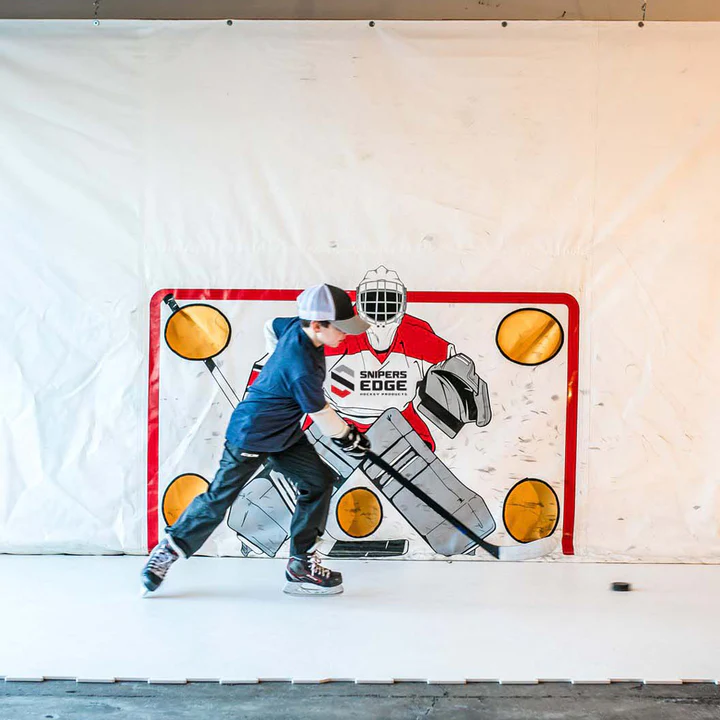We hear it all the time: Hockey players would love to be able to practice skating, shooting, and stick-handling every month of the year, but because of limitations caused by weather, space, and budget, this has long been little more than a pipe dream for most. Players in warmer climates can even have a tough time practicing skating on their own during the winter season because it’s too warm for public outdoor rinks and too costly to reserve indoor ice time. Historically, the synthetic ice options on the market don’t connect together, don’t compare to the feeling of ice, and accomplish little more than dulling your skates.
Thanks to advancements in technology with synthetic ice, year-round at-home training has become a much more achievable reality for skaters of all ages and skill levels – at an affordable price and with minimal setup and maintenance, as well. Some products on the market require a lot of maintenance, including lubrication sprays, difficult assembly, and frequent replacement – but other options offer a much more plug-and-play experience.
Here is a closer look at what synthetic ice is, how it works, and how to use it to sharpen your game in the summer, winter, and anytime in between.
What is Synthetic Ice?
Synthetic ice is a skating surface made from highly engineered high-density polyethylene (HDPE) or ultra-high molecular weight polyethylene (UHMWPE) that replicates a real ice surface. By installing synthetic ice tiles in your home, gym, or anywhere else, you can get in real, on-ice workouts to keep your game sharp and your legs fresh year-round.
How Does Synthetic Ice Work?
Synthetic ice is most often manufactured in the form of panels or tiles that connect like puzzle pieces using either tongue-and-groove, dovetail, or flush-edge connection methods. Sniper’s Edge synthetic ice uses the dovetail connection to provide a double-sided, reversible product that can be flipped over and used while the self-lubrication works to remove marks from skates.
When you skate on natural ice, your skate’s blade increases the temperature of the top layer of ice, melting it to produce a small amount of water that reduces drag and causes the blade to glide smoothly across the top.
On synthetic ice, this reaction is fabricated using specially engineered properties that simulate real ice. This occurs partly because of HDPE’s low coefficient level of friction, which allows it to perform similarly to natural ice.
How to Use Synthetic Ice
Typically used in locations where frozen ice surfaces are impractical due to temperature, size, or cost, synthetic ice makes it easy to perform on-ice training year-round or from the comfort of your own home. With the amount of energy it costs to refrigerate an ice rink, synthetic ice proves to be a cost-effective and environmentally friendly alternative.
As the engineering continues to improve, so does the ability for skaters in warmer climates to play and practice more often, helping the game of hockey continue to expand.
Sniper’s Edge synthetic ice panels are 2 ft x 4 ft in size and are easy to connect like puzzle pieces by using a rubber mallet or a similar tool. For best results, the surface should be set up on top of a stable, level surface such as a garage or basement floor. The dovetail shape helps to create a firm connection that is difficult to come apart. When you use the mallet, you’ll notice the pieces of the panels will fly off, and the lines aren’t able to be distinguished. It creates a smooth finish.
Once assembled per the instructions, you’re ready to start skating! Because our tiles are self-lubricating, no sprays or cleaners are required, and the more you use them the more closely they’ll replicate real ice.
Synthetic ice panels do have slightly more friction than natural ice, which means they require a little added effort to practice glides, edges, turns, and other small-area drills. Many skaters view this as an added benefit for resistance training and find that after skating on synthetic ice, natural ice feels much smoother and more effortless. Especially for younger athletes, synthetic ice can be a great way to help them learn to balance on their blades and master their edges.
Benefits of Synthetic Ice
Synthetic ice makes it easy for hockey players of all ages and skill levels to practice skating and other training routines year-round in almost any environment. Our tiles are engineered with UV-protection, water-resistance, and durability for cars to drive and park on!
Other benefits of Sniper’s Edge synthetic ice tiles include:
- Ability to customize skating surface dimensions based on size and layout of your environment
- Easy setup and maintenance
- Reversibility for longer-lasting use
- No refrigeration required
- Resistance to damage from precipitation, high temperatures, UV exposure, and other outdoor threats
- Toughness and capability to support the weight of a parked car
- Self-lubrication to increase performance with prolonged use
Sharpen Your Skills Year-Round with Sniper’s Edge
Sniper’s Edge helps skaters and players elevate their game anytime, anywhere with hockey training products and accessories that are rugged, battle-tested, and simply fun to use. Each box of our synthetic ice tiles comes with four panels measuring 2 ft x 4 ft to create a skateable area of about 30 square feet.
Designed with self-lubricating additives to maintain shape and slipperiness for years after purchase, our synthetic ice tiles work great with skates, shoes, bare feet, and inline skates (although too slippery for inline skating) and are the easiest and most effective way to get an on-ice workout in no matter your budget or environment.
Shop our products today to find everything you need to keep developing your game from one season to the next.


